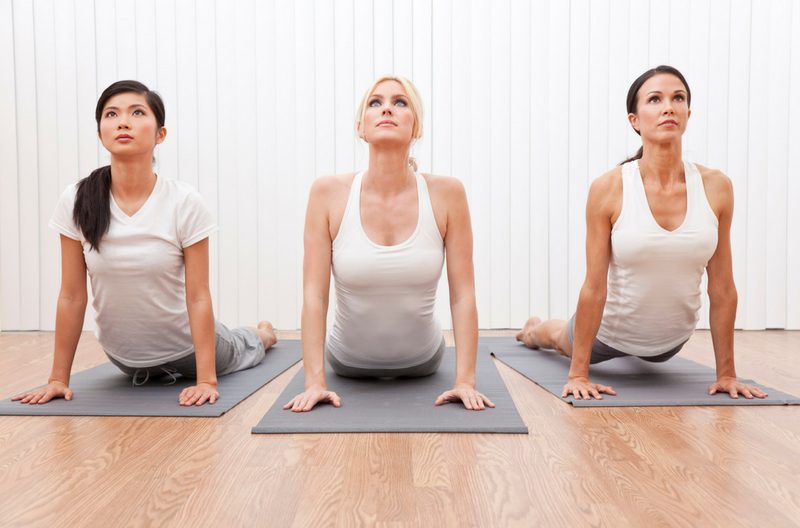Are you interested in yoga but feel unsure of how to get started? Does it sometimes seem a bit intimidating to you? Believe it or not, if you can go into this healthy habit with an open mind, you can get a lot out of it. Sure, it’s exercise, but it’s so much more than that too! Regardless of your fitness level, giving yoga a whirl could have a whole host of benefits. Luckily, trying a beginner yoga sequence could be a quick and easy way to get started.
Of course, there are certain poses that you may find to be useful as you begin your yoga journey. These particular yoga positions for beginners can help you to really get accustomed to what the practice is all about. They can help you to feel the power as you move through poses. If you’re looking for a straightforward way to learn about yoga, you’ve come to the right place. Here’s an easy-to-understand introduction to the activity.
What Are the Best Yoga Positions for Beginners?
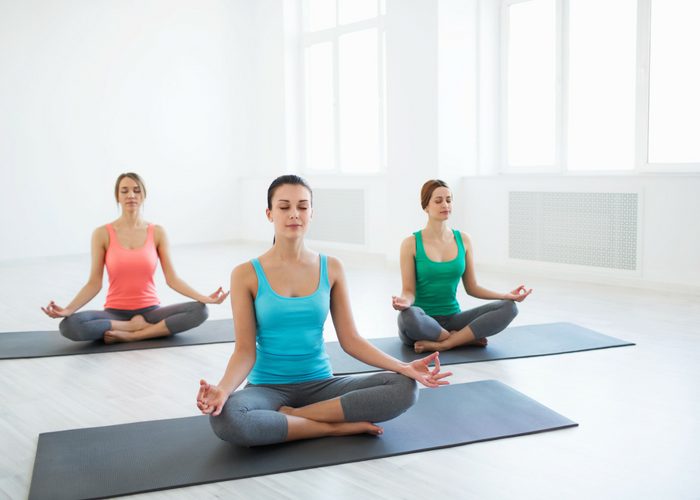
Before we take a look at a beginner yoga sequence, let’s take a moment to go over the basics. You’re probably wondering what the best yoga positions for beginners are. Since there are so many different positions out there (all of which suit different skill levels), finding the ones that suit you may seem tough. Here are some of the best poses and yoga stretches for beginners:
- Triangle Pose
- Yoga Child Pose
- Mountain Pose
- Basic Warrior Pose
- Half Forward Pose
- Tree Pose
- Downward Dog
- Cobra
You have likely heard of some of these while others will be less familiar to you. All of the above are basic positions, which means that you can try them without having any experience in terms of yoga at all. They may also feature in more complex sequences as you progress.
Think of them as your foundation – the poses that you absolutely need to get right. Now that you are familiar with some of the names of the best yoga for beginners poses, we can use some of the above to create an ideal beginner yoga sequence that you can try at home.
Get Started with the Ultimate Beginner Yoga Sequence
Ready to get started? The best yoga for beginners is both approachable and doesn’t take too long to master. Perfecting the following sequence will start you on a journey toward understanding yoga. At first, you may find it a little challenging. However, you need to persevere and keep going. Let’s take a look at some of the yoga positions for beginners and why you should try them.
1. Mountain Pose
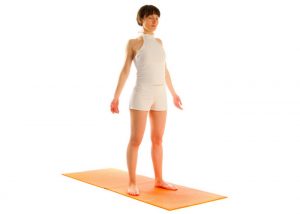
This may be the simplest and most basic of the yoga poses out there. It’s how you essentially get grounded for the yoga workout ahead. At its core, this pose is about standing which makes it perfect for a beginner yoga sequence. It is also how you get your bearings and how you begin to emit energy out of the body. As you are standing there, you are also radiating energy through your heels, your feet, and your entire body.
- What It’s Good For
This position is a starting point when it comes to your yoga sequence. You can also use it to reset whenever you need to do so. Alternately, it may also be something you do in conjunction with meditation and deep breathing exercises. If that’s the case, it can also work as a standalone pose. When we start to learn about the best yoga for beginners, the mountain pose is an all-too-obvious starting point. - How to Do It
Start in standing position with your feet close together. You should make sure the weight is evenly distributed on each foot. Allow each arm to hang down by your side and bring your palms to face forward. Practice mindful breathing. Stand with great power and energy in this pose and see how it can strengthen and lengthen you, work at your posture, and also build your confidence in your yoga practice. - How Long to Do It
How long you hold the mountain pose depends entirely on why you’re doing it. If, for example, it’s the starting point of your beginner yoga sequence, you will need to hold it for a minute or two and no longer. On the other hand, should you wish to meditate or practice your breathing, it may make sense to maintain this position for around 5-6 minutes.
2. Downward Dog
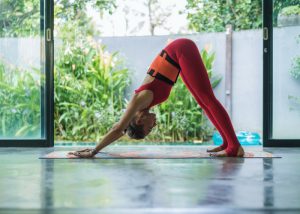
One of the most common poses for a beginner yoga sequence, the downward dog is one you will come across time and time again. Start slowly, keep practicing it, and you will find that you can perfect this position. This will become an instrumental pose as you transition through a full yoga practice, so it’s best to learn it early and keep at it.
- What It’s Good For
As one of the best yoga positions for beginners, this boosts both your flexibility and stamina. It also helps to stretch and strengthen the spine and every muscle group. Every area of your body engages as you hold this unique pose, and so it is about strength just as much as it is cardio. This is often mixed in or used as a transition pose in any given beginner yoga sequence. - How to Do It
Start by getting down on all fours (much like a dog or any four-legged creature). Next, lift up through your feet to a standing position. Your hands should remain firmly on the ground with your arms stretched out before you. Then, hold this position in which your lower half is on the ground while your upper half is almost standing. - How Long to Do It
Finding it hard to stay in this position? Don’t panic. Often used as a transitional pose, downward dog is not something you have to hold for a long period. Try to maintain this stance for 2-3 breaths when you first start out. As a yoga beginner, you will need to take some time to build up to longer periods here.
3. Cobra
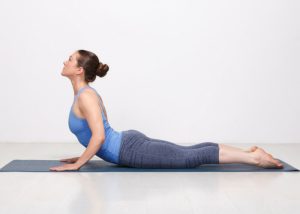
Ready to take things to the next level? The cobra position is one of the yoga stretches for beginners that just feels so good to do. In reality, it’s more of a deep stretch than it is a pose. When you have worked out how to perfect it, you will likely find yourself coming back to it time and time again. It’s quite addictive. Be aware that, while it may sound tricky at first, it’s not as tough as you imagine.
- What It’s Good For
This particular position gives your back a real stretch as you hold the pose at the top. Let the energy flow through your arms as they support the weight of your body. It may be a strange feeling at first but you will come to love how it stretches you out. It also works towards your flexibility and it’s a great pose to transition to something else, so it has a very universal place in a beginner yoga sequence. - How to Do It
Start by lying down on the ground flat with your face down. Then, lift your body upward using only the strength of your arms. You should put your hands flat on the ground to support your body weight. Push upward and maintain a solid core throughout. Doing so will lift you up at an extreme angle. Your upper half up should be entirely off the ground while your lower half just touching. Feel the stretch and breathe! - How Long to Do It
Ideally, you should hold this pose for around 30 seconds at the top. Should that be too challenging, you may wish to start by trying to hold it for 15-20 seconds. As you progress and get better at this beginner yoga sequence, you should find that it becomes easier to hold the cobra position for a long time.
4. Child’s Pose
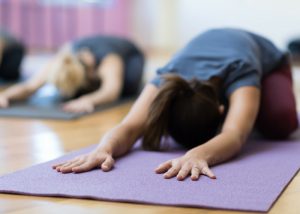
The next pose in the beginner yoga sequence is the child’s pose. Many instructors include this at the end of a yoga practice. The reason for that is that it helps with meditation. It could be the most relaxing of yoga positions for beginners and that’s why so many people love it. It takes a lot of strength to hold this position, and yet rather than being challenging, it feels like a relief.
- What It’s Good For
The yoga child pose may be your ‘go to’ when you need a decent stretch or want to relax. Not only will this position help you to become more flexible over time but it will also allow you to have some head space and revitalize yourself. Pair it with deep breathing exercises to make sure you reap the greatest wellness rewards. - How to Do It
Simply start by laying flat on your stomach with your head down on the floor. Stretch your arms out in front of you. While keeping your body flat, bend your knees and scoot your entire lower half backward as far as possible. When you get this right, your arms should be stretched out as far as they can reach in one direction. It’s a deep stretch. - How Long to Do It
As the yoga child pose is as much meditative as it is about flexibility, the longer you can hold it the better. At first, since you are a complete yoga beginner, you may find that it’s easiest to try to hold it for around 20 seconds. If you can manage more, though, you could find that you start to truly unwind.
5. Warrior
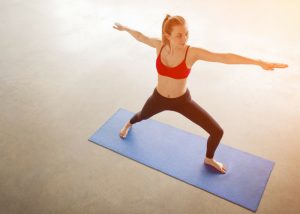
While most don’t realize it, there’s an entire series of warrior poses. As a yoga beginner, though, you should start small. You’ll need to learn to master the most basic warrior pose first. After that, you will have the chance to build on what you already know and start experimenting with some of the many variations of these yoga positions for beginners.
- What It’s Good For
There is great power in the primary warrior position as your feet are planted firmly into the ground. It is one of the yoga stretches for beginners which will help you to strengthen your overall practice while feeling empowered and strong at the same time. You can also tap into the mental benefits of yoga while in this stance as it’s all about confidence. - How to Do It
For the basic warrior pose, stand with your feet planted firmly on the ground. Move one leg out in front of you and bend it at the knee. You should keep the back leg as straight as you can. Put one arm out in front of you and the other behind you. Hold them firmly. - How Long to Do It
You don’t need to hold the warrior pose for too long to start to get some of the health benefits of yoga. Try to maintain a strong position for around 10-20 seconds before switching sides. You can easily work this position into a beginner yoga sequence and it’s certain to become one of your fast favorites.
6. Bridge Pose
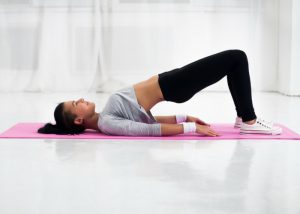
The bridge pose may feel a little familiar when you first give it a go. You have probably already done something like this without realizing that it was a yoga pose. However, when you’re a yoga beginner, you should take the time to understand the power that you have when executing this movement. It’s all about precision and control.
- What It’s Good For
Primarily, you will find that the bridge pose targets your core, back, and glutes. This means that you can start to take advantage of some of the greatest physical benefits of yoga. These muscle groups are essential in many sequences so strengthening them is a positive move, to say the least. - How to Do It
Start by laying flat on the ground. You will need to keep your back and upper half in the same grounded position throughout the entire pose. Bend your knees while placing your feet flat on the ground. Slowly lift your lower half up moving one single vertebra at a time. Take in every inch of it. When you reach the top, hold for a second, and then slowly start to move back down to the starting position. Be sure to concentrate on the muscle groups that propel you through this movement. - How Long to Do It
The entire pose should take you no more than around ten seconds. You will need to lift up to the top of the bridge position, hold it there, and then return to the start again. Of course, it should go without saying that you can repeat this movement as many times as suits you. For a tougher beginner yoga sequence, for example, you may add more repetitions to this particular movement. It’s entirely up to you.
7. Tree Pose
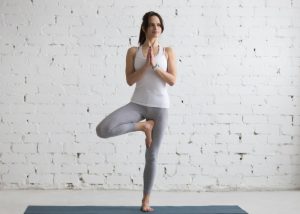
Here’s a pose that may be less-than-familiar to most of you when you first enter the mysterious world of yoga. Quite unsurprisingly, this pose gets its name as you look almost like a tree when you try it. While it may sound a little silly, it is one of the most effective yoga stretches for beginners and one that you should never overlook. Master this one and you’re off to a truly great start.
- What It’s Good For
Balance and flexibility are two of the foundations of any beginner yoga sequence. Luckily, the tree pose can help in both of these areas. You may find that it’s tremendously tricky to stay balanced when you are completely new to this pose. There’s power in the process. When you keep trying to get it right, you will boost your endurance levels too. - How to Do It
Start by standing straight up with your shoulders held in place. Then slowly lift one foot up to rest it on the opposite leg, just below the knee. Hold this pose as you bring your arms together up over your head and clasp the hands together. The hardest part is keeping your foot held against the opposite leg, but it’s a fun challenge to try. Be sure to feel the immense power through the foot on the opposite leg and through the arms as well. Your arms should remain up overhead as you hold the pose. Remember, the more time you spend practicing this pose, the more you will get out of it. - How Long to Do It
This is one of the yoga positions for beginners, which can be strikingly hard to hold for an extended period. For that reason, you may need to work your way up to longer holds. Start by trying to balance for at least 10 seconds. As you develop your skill set and improve your balance, you should find that you can progress to minute-long holds.
What Are the Health Benefits of Yoga?
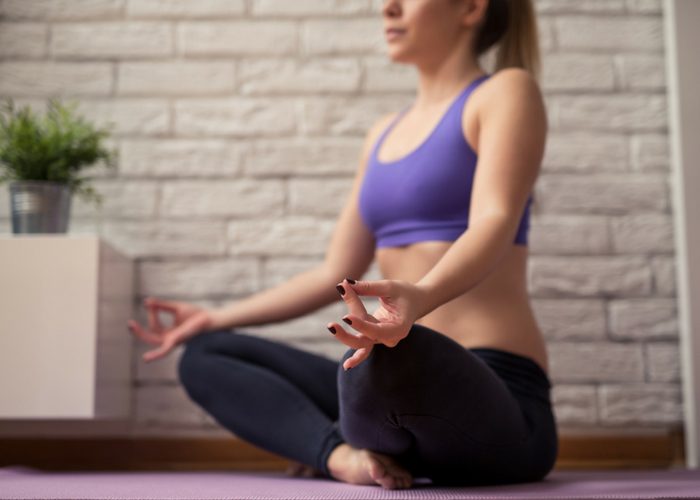
Could Prevent Obesity
Many Americans now struggle with weight-related conditions. In fact, more than one in three adults are considered obese, according to statistics from the National Health and Nutrition Examination Survey (NHANES).[1] Obesity can often lead to health concerns such as type 2 diabetes, an increased risk of stroke, and even death. Needless to say, it’s a problem that you should tackle head-on and as soon as possible.
Giving yoga a shot could be a great place to start. One study from the Fred Hutchinson Cancer Research Center found that regular yoga sessions are often linked with mindful eating.[2] When people start to practice mindful eating, they often lose weight and those committed to this process tend to be less likely to be obese as well. Becoming a yoga beginner, it could impact every area of your life, not least your waistline.
Eases Back Pain
Chronic back pain can affect almost every area of your life. This ongoing health condition may sound relatively innocuous but it makes day-to-day tasks more difficult than you imagine. Of course, there are painkillers and medication you can take but if you’re looking for a more natural approach, you could give a beginner yoga sequence a try.
Research from the Group Health Research Institute found that yoga was more effective than both stretching classes and self-care when it came to combatting lower back pain.[3] While it’s unlikely to relieve you of all your aches and pains, learning some yoga stretches for beginners could help you to manage your symptoms better than before.
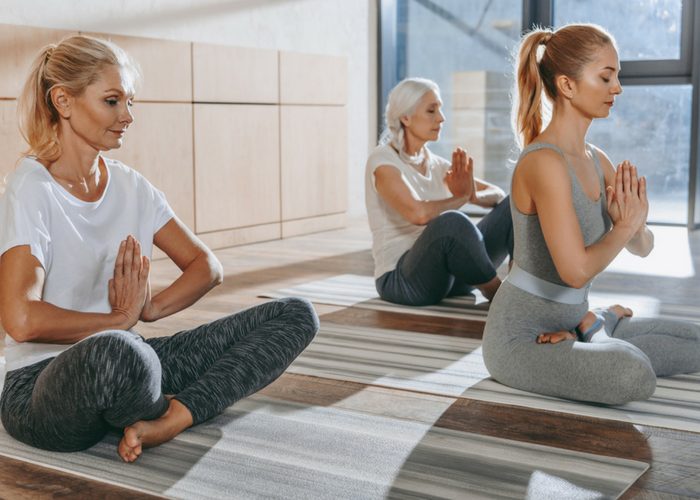
Reduces Symptoms of Depression
It’s not just about low moods and bouts of sadness. Major Depressive Disorder (MDD) affects 16.1 million American adults and is the leading cause of disability in the US for people between the ages of 15 and 44 years old.[4] The problem can affect anybody but is more prevalent in women than it is men.
Often enough, tackling the problem can be a real battle. From forms of therapy to medication, there’s no end to supposed solutions to this growing problem. Many people simply don’t know where to start. However, one of the most effective ways to manage depression could be to get more active and include yoga in your regular routine. Doing so could help you to harness the power of positivity and turn things around.
One of the most exciting mental benefits of yoga is that the practice could help people to combat their depressive moods. In fact, research from the American Psychological Association (APA) found that including yoga in your everyday routine could effectively complement traditional depression treatments.[5] The fact that this activity reduces the symptoms of depression means that it could be a perfect holistic form of treatment.
Relieves Stress
Do you feel stressed out on a daily basis? While you may think that a little stress here and there is no big deal, it could be affecting your health more than you know. The symptoms of this problem include feeling overwhelmed, anxious, irritable, wound up, and lacking self-esteem. Plus, some of the many physical manifestations may include headaches, dizziness, and sleep problems too.[6]
For all of these reasons, relieving your stress levels is one of the best things you can do for your wellness. You can’t always avoid stressful situations. So, tackling this issue properly is about building up your resilience levels. One study published in Frontiers found that both yoga and meditation could help people to improve how they respond to stress.[7] Taking the time to include yoga in your routine could make you feel at ease.
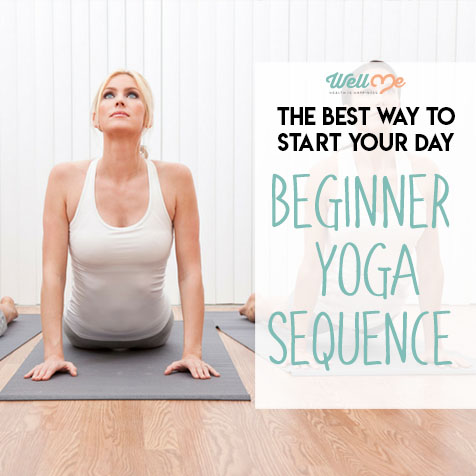
Conclusion: Get Started Today
Trying out a beginner yoga sequence can be an amazing way of getting centered. It’s exercise, it’s meditation, and it’s so good for your mental, physical, and even emotional well-being. If you are new to it, there’s no need to worry for there are poses you can start with on a very elementary basis. Work to master these and then see how you can build yourself up. Here are some tips that could help when you first begin:
- Look for a yoga class in your area
- Invest in key yoga gear, such as a mat, balance ball, and clothing
- Watch videos and tutorials online
- Ask a friend to join you for a session
- Practice, practice… and practice some more
Now that you’ve got all the details and understand the beginner yoga sequence, what are you waiting for? Before you start, remember the golden rule here. Don’t get discouraged and be sure to go into this activity with an open mind. You never know just might find that you love these so much that you want to stick with the practice in the long term.
References
- [1] https://www.niddk.nih.gov/health-information/health-statistics/overweight-obesity
- [2] https://linkinghub.elsevier.com/retrieve/pii/S0002822309006282
- [3] https://jamanetwork.com/journals/jamainternalmedicine/fullarticle/1106098
- [4] https://adaa.org/about-adaa/press-room/facts-statistics
- [5] http://www.apa.org/news/press/releases/2017/08/yoga-depression.pdf
- [6] https://www.nhs.uk/conditions/stress-anxiety-depression/understanding-stress/#symptoms-of-stress
- [7] https://www.frontiersin.org/articles/10.3389/fnhum.2017.00315/full

